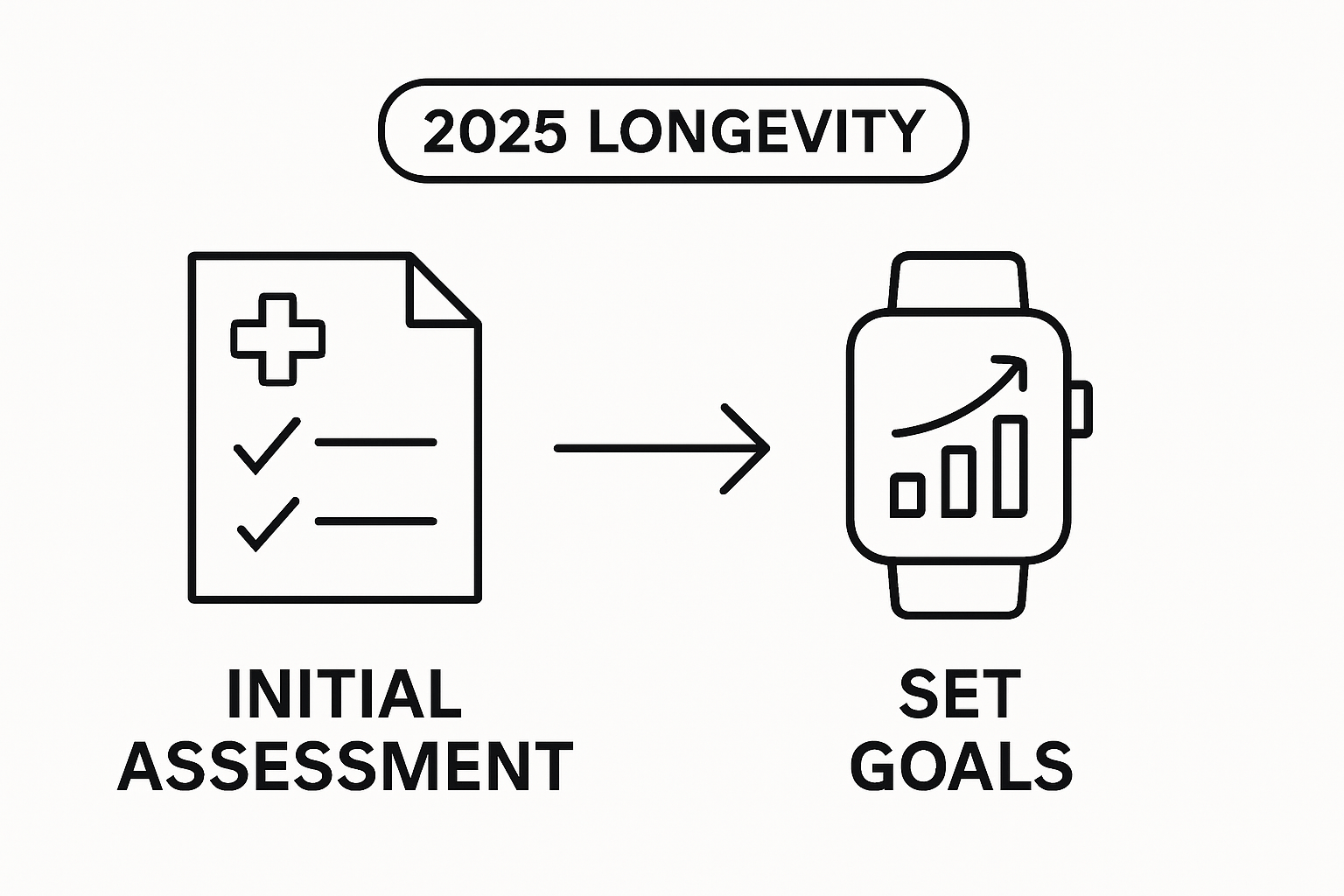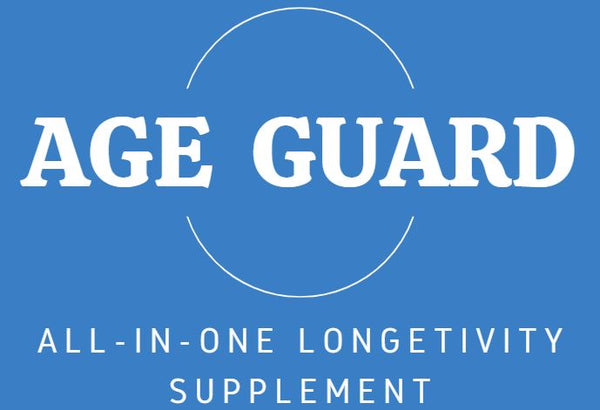
How to Start Healthy Aging: A 2025 Guide to Longevity
Share
Everyone talks about living longer and feeling younger, but most people never realize that the real power lies in the smallest daily choices. Here is something that stands out. Only about 20 percent of longevity is determined by genetics, while up to 80 percent is influenced by lifestyle factors and personal habits. So the surprising truth is you have way more control over how you age than you probably think. Tiny adjustments today could completely rewrite your future health.
Table of Contents
- Step 1: Assess Your Current Health And Lifestyle
- Step 2: Set Specific Health Goals For Longevity
- Step 3: Incorporate Nutrient-Rich Foods Into Your Diet
- Step 4: Establish A Consistent Exercise Routine
- Step 5: Choose Science-Backed Supplements Wisely
- Step 6: Monitor Your Progress And Adjust As Needed
Quick Summary
| Key Point | Explanation |
|---|---|
| 1. Conduct a thorough health assessment | Begin your healthy aging journey by evaluating your physical and mental health with medical checkups and lifestyle reflection. |
| 2. Set SMART health goals | Develop specific, measurable, achievable, relevant, and time-bound goals based on your initial health assessment for better focus. |
| 3. Prioritize nutrient-rich foods | Transform your diet by incorporating whole, minimally processed foods rich in antioxidants and essential nutrients to support wellness. |
| 4. Establish a consistent exercise routine | Create a balanced exercise plan that includes cardiovascular, strength, flexibility, and balance activities tailored for aging. |
| 5. Monitor your progress regularly | Use tracking tools and regular assessments to adapt your health strategies as needed, ensuring continuous improvement in aging. |
Step 1: Assess Your Current Health and Lifestyle
Launching your healthy aging journey begins with a comprehensive self-assessment of your current health status and lifestyle patterns. This critical first step provides a foundational baseline that will help you design a personalized strategy for longevity and wellness.
Starting your assessment requires honest self-reflection and gathering objective data about your physical and mental well-being. Begin by scheduling a comprehensive medical checkup with your primary healthcare provider. During this examination, request a full panel of diagnostic tests that will offer insights into key health markers. These typically include:
- Blood pressure screening
- Comprehensive metabolic panel
- Lipid profile
- Blood glucose levels
- Hormone level assessment
- Vitamin and mineral deficiency screening
Beyond medical tests, evaluate your lifestyle through a holistic lens. Critically examine your daily habits across nutrition, physical activity, stress management, and sleep patterns. Document your typical diet, tracking not just caloric intake but nutrient quality. Assess your current exercise routine, noting frequency, intensity, and types of physical activities you engage in.
Mental and emotional health are equally crucial components of your healthy aging assessment. Reflect on your stress levels, emotional resilience, and psychological well-being. Consider using standardized mental health screening tools or consulting a therapist to gain deeper insights into your psychological landscape.
According to Stanford Center on Longevity, a thorough baseline assessment helps individuals create more targeted and effective aging strategies. By understanding your current health status, you can develop precise interventions that address potential risk factors and optimize your wellness trajectory.
Compile all gathered information into a comprehensive personal health profile. This document will serve as your roadmap, allowing you to track progress, set realistic goals, and make informed decisions about your long-term health and aging process.
Below is a table summarizing the main types of diagnostic tests and lifestyle evaluation areas recommended for your initial health and lifestyle assessment.
| Assessment Area | What to Check | Purpose/Benefit |
|---|---|---|
| Blood Pressure | Systolic/diastolic readings | Detect hypertension and cardiovascular risks |
| Comprehensive Metabolic Panel | Glucose, kidney, and liver function markers | Evaluate overall organ and metabolic health |
| Lipid Profile | Cholesterol and triglyceride levels | Assess cardiovascular and metabolic health |
| Hormone Level Assessment | Thyroid, testosterone, estrogen, etc. | Identify hormonal imbalances/aging factors |
| Vitamin/Mineral Deficiency Screen | Vitamin D, B12, iron, magnesium, and more | Reveal nutritional gaps |
| Mental Health Screening | Stress, resilience, mood assessments | Understand emotional and psychological state |
| Lifestyle Habits Review | Diet, exercise, sleep, stress management | Identify modifiable risk factors |
 Remember, this assessment is not about judgment but empowerment – providing you with the knowledge to make proactive, strategic choices for your future well-being.
Remember, this assessment is not about judgment but empowerment – providing you with the knowledge to make proactive, strategic choices for your future well-being.
Step 2: Set Specific Health Goals for Longevity
Transforming your health assessment into a powerful roadmap for longevity requires creating strategic and personalized health goals. This step moves you beyond passive observation into active, intentional planning for your long-term wellness journey.
Goal setting is not about creating an overwhelming list of expectations, but designing realistic, achievable targets that progressively enhance your overall health. Start by reviewing your initial health assessment and identifying specific areas where meaningful improvements can be made. These might include reducing cardiovascular risk factors, improving metabolic health, enhancing muscle strength, or optimizing cognitive function.
Craft your goals using the SMART framework - Specific, Measurable, Achievable, Relevant, and Time-bound. For instance, instead of a vague goal like “get healthier,” develop a precise objective such as “reduce resting heart rate by 5 beats per minute within six months through consistent cardiovascular exercise and stress management techniques.”
Consider developing goals across multiple wellness dimensions. Physical fitness goals might focus on strength training frequency, cardiovascular endurance, or flexibility. Nutritional objectives could target specific dietary modifications like increasing plant-based protein intake or reducing processed food consumption. Mental health goals might involve meditation practice, stress reduction techniques, or cognitive stimulation activities.
According to the Stanford Center on Longevity, successful longevity strategies require dynamic, adaptable goal setting. This means periodically reassessing and adjusting your objectives as your body changes and you progress through different life stages.
Create a structured tracking system to monitor your progress. This could involve a dedicated health journal, digital wellness apps, or quarterly check-ins with healthcare professionals. Visual representations like progress charts or milestone trackers can provide motivation and help you stay accountable.
Remember that goal setting is a personal journey. Be compassionate with yourself, celebrate small victories, and understand that consistent, incremental progress matters more than perfection. Your goals should inspire and energize you, not create additional stress or unrealistic expectations.
Step 3: Incorporate Nutrient-Rich Foods into Your Diet
Nutrition serves as the fundamental cornerstone of healthy aging, transforming your diet from a mere source of calories into a powerful longevity strategy. This step focuses on deliberately selecting foods that provide maximum nutritional benefits and support cellular health, metabolism, and overall wellness.
Begin by reimagining your plate as a palette of therapeutic nutrients rather than just a meal. Prioritize whole, minimally processed foods that deliver concentrated nutritional profiles. Focus on integrating foods rich in antioxidants, omega-3 fatty acids, and essential micronutrients that combat cellular aging and support metabolic function.
Construct your dietary approach around diverse plant-based proteins, colorful vegetables, and nutrient-dense ingredients. Incorporate foods like wild-caught salmon, which provides critical omega-3s, dark leafy greens packed with vitamins and minerals, and berries offering potent antioxidant protection. Include sources of lean protein such as legumes, quinoa, and organic poultry to support muscle maintenance and cellular repair.
Expand your nutritional strategy by introducing functional foods known for their anti-aging properties. Turmeric with its powerful anti-inflammatory curcumin, green tea loaded with polyphenols, and fermented foods like kimchi and kefir that support gut microbiome health represent strategic dietary additions. These foods work synergistically to reduce oxidative stress and support cellular regeneration.
Mindful meal preparation becomes crucial in this process. Invest time in learning cooking techniques that preserve nutritional integrity. Steaming, light sautéing, and raw preparations help maintain vitamin and mineral content. Consider batch cooking nutrient-dense meals that can be easily stored and quickly reheated, ensuring consistent access to high-quality nutrition.
According to Harvard School of Public Health, dietary diversity and quality are more important than strict caloric restrictions. Your goal is creating a sustainable eating pattern that nourishes your body and supports long-term health.
Establish a weekly meal planning routine that systematically integrates these nutritional principles. Use a digital meal tracking app or a dedicated journal to monitor your dietary composition, ensuring you consistently meet your nutritional goals.
This table presents common categories of nutrient-rich and functional foods for healthy aging, along with key examples and primary benefits based on the article’s recommendations.
| Food Category | Key Examples | Main Benefit for Healthy Aging |
|---|---|---|
| Omega-3 Rich Foods | Wild-caught salmon, flaxseed | Support heart and cellular health |
| Leafy Greens/Vegetables | Spinach, kale, broccoli | High vitamins, minerals, antioxidants |
| Colorful Berries | Blueberries, raspberries | Potent antioxidant protection |
| Lean Proteins | Legumes, quinoa, organic poultry | Maintain muscle, support metabolism |
| Functional/Anti-Aging | Turmeric, green tea, kimchi, kefir | Reduce inflammation, aid gut health |
| Whole Minimally Processed | Lentils, oats, sweet potatoes | Provide sustained energy and nutrients |

Step 4: Establish a Consistent Exercise Routine
Transforming your physical health requires developing a strategic and sustainable exercise routine that addresses the comprehensive wellness needs of aging bodies. This step goes beyond simple movement, focusing on creating a holistic approach that enhances strength, flexibility, cardiovascular health, and cognitive function.
Begin by understanding that exercise for healthy aging is not about intense, punishing workouts, but about consistent, intelligent movement that supports your body’s changing capabilities. Design a balanced routine that incorporates four critical exercise domains: cardiovascular conditioning, strength training, flexibility work, and balance enhancement.
Start with cardiovascular exercises that elevate your heart rate without overtaxing your system. This might include brisk walking, swimming, cycling, or low-impact aerobic classes specifically designed for mature adults. Aim for 150 minutes of moderate-intensity activity weekly, broken into manageable sessions that feel challenging yet achievable.
Strength training becomes increasingly crucial as we age. Incorporate resistance exercises using bodyweight, resistance bands, or light weights to maintain muscle mass and support metabolic health. Focus on compound movements that engage multiple muscle groups simultaneously, such as squats, modified push-ups, and resistance band pulls. Begin with lighter weights and gradually increase intensity, prioritizing proper form over lifting heavy loads.
Flexibility and mobility work are essential components often overlooked in exercise routines. Integrate practices like yoga, gentle stretching, and mobility drills that maintain joint health and prevent stiffness. These activities not only improve physical range of motion but also provide mental relaxation and stress reduction benefits.
According to the Harvard School of Public Health, exercise consistency matters more than intensity. Create a realistic schedule that fits seamlessly into your lifestyle, making physical activity feel less like a chore and more like an enjoyable part of your daily routine.
Implement accountability strategies to maintain motivation. This could involve joining group fitness classes, partnering with an exercise buddy, or using fitness tracking apps that log your progress and provide gentle reminders. Remember that modifications are always acceptable - listen to your body and adjust your routine as needed, celebrating small victories and maintaining a positive, patient approach to your fitness journey.
Step 5: Choose Science-Backed Supplements Wisely
Navigating the complex world of dietary supplements requires a strategic and informed approach, transforming these nutritional additions from random purchases into targeted tools for supporting your healthy aging journey. This step focuses on developing a scientifically grounded supplement strategy that complements your nutrition and lifestyle goals.
Begin by understanding that supplements are not magic solutions but precise nutritional interventions designed to address specific physiological needs. Conduct thorough research into supplements with robust scientific evidence supporting their efficacy in promoting cellular health, reducing inflammation, and supporting metabolic function. Prioritize compounds like omega-3 fatty acids, vitamin D, magnesium, and targeted anti-aging molecules that have demonstrated measurable benefits in clinical studies.
Consult with healthcare professionals who specialize in integrative or functional medicine to develop a personalized supplement protocol. These experts can conduct comprehensive blood tests to identify specific nutritional deficiencies and recommend targeted supplementation strategies tailored to your unique biochemical profile. This personalized approach ensures you’re addressing your body’s precise nutritional requirements rather than following generic recommendations.
When selecting supplements, prioritize quality and transparency. Look for brands that provide third-party testing results, clear ingredient sourcing information, and scientifically validated dosages. Avoid products with excessive proprietary blends or unclear ingredient concentrations. Consider our optimized longevity formula which combines carefully researched compounds specifically designed to support cellular health and aging processes.
According to the Harvard School of Public Health, supplements should complement, not replace, a balanced diet and healthy lifestyle. Develop a systematic approach to supplement integration, tracking your body’s response through regular health assessments and being willing to adjust your protocol based on emerging scientific research and your individual health markers.
Implement a disciplined tracking system to monitor supplement effectiveness. Maintain a detailed journal documenting your supplement intake, noting any changes in energy levels, cognitive function, physical performance, and overall well-being. This methodical approach transforms supplement consumption from a passive activity into an active, data-driven wellness strategy.
Step 6: Monitor Your Progress and Adjust as Needed
Healthy aging is not a static destination but a dynamic journey requiring continuous assessment, reflection, and strategic adaptation. This critical step transforms your longevity plan from a rigid blueprint into a responsive, personalized roadmap that evolves alongside your changing physiological needs.
Develop a comprehensive tracking system that goes beyond simple metrics, creating a holistic view of your physical, mental, and metabolic health. Invest in advanced health monitoring tools that provide granular insights into your biological aging process. This might include periodic blood work analyzing inflammatory markers, hormonal panels, metabolic indicators, and cellular health parameters.
Utilize digital health technologies to streamline your progress monitoring. Wearable devices and smartphone applications can track critical health metrics like heart rate variability, sleep quality, daily activity levels, and stress responses. These tools provide real-time data, allowing you to make immediate, informed adjustments to your wellness strategy.
Schedule quarterly comprehensive health assessments with healthcare professionals specializing in integrative or functional medicine. These evaluations should include detailed physical examinations, advanced diagnostic tests, and comprehensive consultations that explore not just your physical health, but also your cognitive function, emotional well-being, and overall quality of life.
According to Stanford Center on Longevity, successful aging requires adaptable strategies that respond to individual physiological changes. Be prepared to modify your nutrition, exercise, supplement, and lifestyle protocols based on emerging data and your body’s unique responses.
Develop a flexible mindset that views health adjustments as opportunities for optimization rather than setbacks. Create a structured journaling system to document your experiences, tracking not just quantitative metrics but also qualitative changes in energy levels, mental clarity, emotional resilience, and overall sense of well-being.
Establish clear, measurable indicators of progress that extend beyond traditional medical markers. These might include improvements in functional strength, flexibility, cognitive performance, stress management capabilities, and overall life satisfaction. Remember that healthy aging is a holistic journey of continuous learning, adaptation, and personal growth.
Take Charge of Your Healthy Aging Journey with Age Guard
You have invested time in understanding your body, setting clear goals, and exploring proven longevity strategies. Yet bridging the gap between knowledge and results often means facing challenges like filling nutritional gaps, supporting cellular repair, and maintaining daily consistency. If your health assessment highlights specific needs like enhanced energy, optimized cellular health, or antioxidant protection, you are not alone. Many find it is difficult to translate personalized plans into sustainable outcomes without science-backed support. Our article points out the need for precision and evidence in supplement choices. That is exactly where MyAgeGuard.com can help you.

Why wait to transform good intentions into measurable progress? Explore the formulation behind Age Guard and uncover the real-world benefits that come from clinically tested ingredients like NMN, collagen, spermidine, and antioxidants. With detailed ingredients and benefits backed by customer reviews and subscription savings, you can act today with total confidence. Make your next step count and start optimizing your healthy aging plan at MyAgeGuard.com.
Frequently Asked Questions
How do I assess my current health for healthy aging?
Begin by scheduling a comprehensive medical check-up that includes diagnostic tests like blood pressure screening, lipid profile, and hormone assessments. Additionally, evaluate your lifestyle habits in areas such as nutrition, exercise, stress management, and sleep patterns to create a thorough health profile.
What framework can I use for setting health goals for longevity?
Use the SMART framework, which stands for Specific, Measurable, Achievable, Relevant, and Time-bound. For example, instead of a vague goal like ‘get healthier,’ you could set a specific goal to ‘reduce resting heart rate by 5 beats per minute within six months.’
What types of foods should I focus on for a nutrient-rich diet?
Prioritize whole, minimally processed foods rich in antioxidants, omega-3 fatty acids, and essential micronutrients. Include diverse plant-based proteins, colorful vegetables, and functional foods like turmeric and green tea that have anti-aging properties to support cellular health.
How can I monitor my progress as I age healthily?
Establish a comprehensive tracking system that includes regular health assessments, wearable devices to monitor metrics like heart rate and sleep quality, and journaling your experiences. This holistic approach allows you to adapt and modify your wellness strategies based on your changing health needs.
